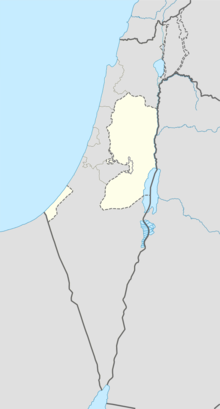Tirzah (ancient city)
תרצה/תל אל-פארעה | |
| Location | Nablus Governorate, Palestinian Territories |
|---|---|
| Coordinates | 32°17′15″N 35°20′16″E / 32.287387°N 35.337803°E |
| Area | 180 dunam 0.18 km² |
| History | |
| Periods | Bronze Age, Iron Age |
Tirzah (
History
The size of the archaeological site is 180 dunams (44 acres) and is located in the hills of Samaria, northeast of Nablus, in what is currently known as the West Bank. The archaeological site is called Tell el-Far'ah (North) in order to distinguish it from Tell el-Far'ah (South), an archaeological site south of Gaza.
Excavations were undertaken at Tell el-Far'ah between 1946 and 1960 for nine seasons by École Biblique under the direction of Roland de Vaux.[6]
Prehistoric period
The site was occupied in the Neolithic and Chalcolithic eras, and became progressively more populated.[7] Finds from the earliest levels of settlement excavated by Dorothy Garrod in 1928 were suggested to date to the Pre-Pottery Neolithic B (PPNB) period.[8]
Bronze Age
During the
In the Middle Bronze Age II, there was a small settlement on the site that used the remnants of the older town walls for protection. In the 1700s the population expanded and a new wall was built, but it enclosed a smaller area than the older city. The Late Bronze Age remains indicate that there was no major urban development during this period.[7]
Iron Age
Tell el-Far'ah was an important town in the early
In the Bible
The town of Tirzah is first mentioned in the
During the time of King
Tirzah is mentioned in when Menahem left it to Samaria, assassinated King Shallum and became King of Israel.[13]
Tirzah is mentioned in Song of Songs, where the lover compares his beloved's beauty to that of Tirzah. If the authorship of Song of Songs can be attributed to Solomon, then this is a reference to the city during the United Monarchy. However, Song of Songs provides no definite historical context to allow it to be dated on that basis.[14]
Modern location
Robinson suggested that Talluza might be ancient Tirzah (Latin form: Thersa), one of 31 Canaanite cities which the Bible lists as having been conquered by Joshua; the modern Arabic name being a derivation of the ancient name by way of its Hebrew form, or possibly its original Canaanite form, whereby the r sound was replaced with a l.[15] French explorer Victor Guérin also argued that Talluza was the site of ancient Thirza.[16] Later, Conder and Kitchener suggested that Tayasir was a more likely candidate;[17] however, today Tell el-Farah (North), northeast of modern Nablus is generally accepted as the site of Tirzah.
References
- ISBN 978-90-5356-503-2.
- ISBN 978-0-664-22084-6.
- ^ Conder & Kitchener (1882), p. 228
- ^ Robinson (1856), p. 303
- ^ Guérin (1874), p. 366
- ^ R. de Vaux, "Les fouilles de Tell el-Far'ah" Revue Biblique 68, 1961, pp. 576-592
- ^ a b c de Vaux, Roland (1992). E.Stern (ed.). האנצקלופדיה החדשה לחפירות ארכיאולוגיות בארץ ישראל [The New Encyclopedia of Archaeological Excavations in the Land of Israel] (in Hebrew). Vol. IV. pp. 1297–1302.
- ISBN 978-0-13-276288-5. Retrieved 2 May 2011.
- ^ Deborah Sebag, The Early Bronze Age Dwellings in the Southern Levant, Bulletin du Centre de recherche français de Jérusalem [En ligne], 16|2005, mis en ligne le 09 octobre 2007, Consulté le 23 mai 2010. URL : http://bcrfj.revues.org/index256.html
- ^ Joshua 12:24
- ^ 1 Kings 14:17
- ^ 1 Kings 15:33, 1 Kings 16:8 and 1 Kings 16:23.
- ^ 2 Kings 15:14
- ^ Song of Songs 6:4
- ^ Robinson and Smith, 1856, pp. 302 -303
- ^ Guerin, 1874, pp. 365-368 ff
- ^ Conder and Kitchener, SWP II, 1882, pp. 216, 228
Bibliography
- Conder, C.R.; Kitchener, H.H. (1882). The Survey of Western Palestine: Memoirs of the Topography, Orography, Hydrography, and Archaeology. Vol. 2. London: Committee of the Palestine Exploration Fund.
- Guérin, V. (1874). Description Géographique Historique et Archéologique de la Palestine (in French). Vol. 2: Samarie, pt. 1. Paris: L'Imprimerie Nationale.
- Robinson, E.; Smith, E. (1856). Later Biblical Researches in Palestine and adjacent regions: A Journal of Travels in the year 1852. London: John Murray.

